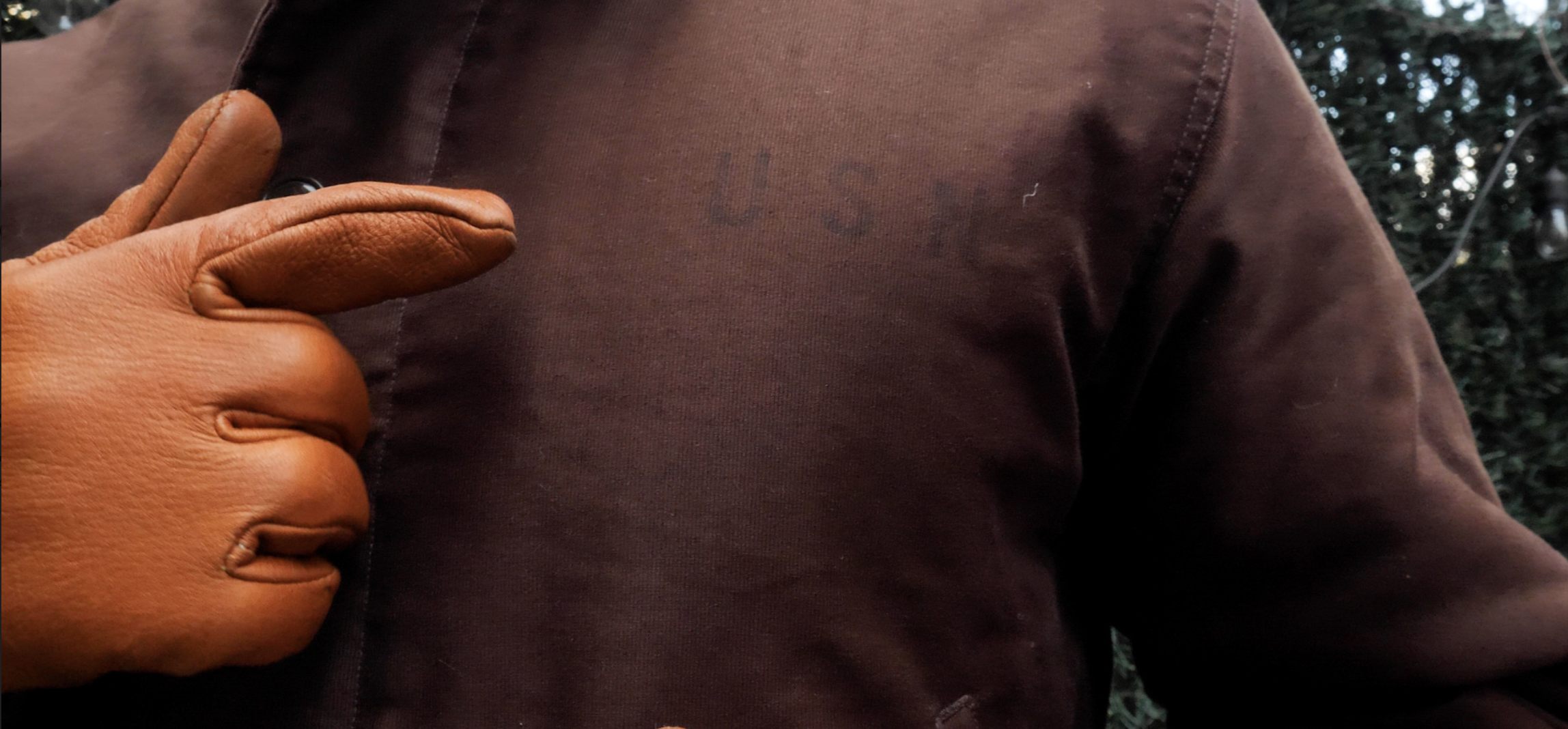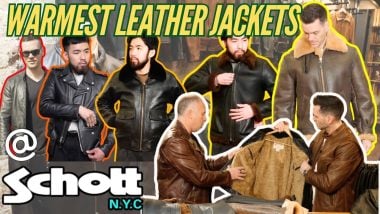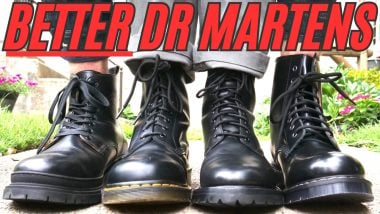The Complete Guide to Deck Jackets | History, Variations, and Why It’s the Best Winter Jacket
This article has been in the making for well over a year, ever since a chance encounter at a London menswear store introduced this writer to a mighty beast of a winter jacket. A casual jacket that’s so warm and so unusual, so understated yet so eye-catching, that several were purchased throughout the following year in an unquenchable thirst to find the all-time best version of this landmark in menswear.
We’re talking about the deck jacket.
After deciding an article would be a perfect excuse to overindulge this fanaticism, four (4) deck jackets were procured so that we could look at how leading companies iterate and perhaps even — gasp — improve upon the 1940s original, devised to keep our hard working naval servicemen warm and dry on the high seas.
We even interviewed a military clothing historian from HistoryPreservation.com to learn more about how this jacket became such a stupendous item of winter wear, before we plunge into the list where I compare materials, historical authenticity, fit, and price.
What Is a Deck Jacket?
- Dense cotton shell made from Bedford cord or jungle cloth
- Wool lining, usually an alpaca blend
- Zipper opening with button placket
- Short length; this isn’t a coat
Deck jackets don’t scream “military” like a lot of vintage-inspired men’s outerwear, and that’s why we like them.
But they’re popular in the nerdy world of heritage replicas because the N-1 Deck Jacket was built for and worn by the US Navy in World War 2, a time before the plethora of artificial materials engulfed the world of outerwear and we kept ourselves warm with natural materials like cotton and wool.
Deck jackets are stylish, durable, and incredibly warm, representing a time before modern materials like nylon and polyester were introduced to jackets in the 1950s.

Who should buy a deck jacket?
- Guys who want a casual jacket that can withstand subzero temperatures
- Anyone who prefers natural materials to synthetics
- People who like the idea of wearing the same jacket their ancestors wore to fight in World War 2
- Men who like apparel that will last a lifetime and will fit better with wear
Who shouldn’t buy a deck jacket?
- People who prefer the lightweight performance of modern materials like polyester and nylon
- Guys who need a waterproof jacket (though mine have managed plenty of snowstorms)
- Anyone with an aversion to emulating military apparel of old

The History of the Deck Jacket
Before civilians like James Dean and Paul Newman donned the deck jacket, it was worn by the good folks at the US Navy. The N1 style that we all know and love today is the 3rd iteration of its kind, with the original being first developed in 1940.
The Navy started this project because they needed something warmer when running around on the US’s relatively new Aircraft Carriers that transported the also-relatively-new US fighter jets during World War II and the Korean War.
Prior to the deck jacket, sailors wore a peacoat over their uniforms when it got colder, but it was soon learned that peacoats are too restrictive for the manual labor duties the servicemen had to perform.

The “Right” Color for a Deck Jacket
When the Navy first designed the jacket, it only came in a dark navy color to symbolize the branch.
However, as the US military saw missions through various parts of the world, their design team decided to add an olive colorway to their catalog. The olive color made it easier for servicemen to blend in and also made it possible for the Navy to stencil in the iconic USN lettering on the chest.

What is strange is that if you look at today’s market, you will see a lot of retailers selling a khaki version.
Knowing that the Navy did not produce a khaki color, I asked historian, Charles Disipio of History Preservation to help me understand why the most ubiquitous deck jacket today is khaki or golden brown.
Aside from the original navy, Charles said that the only other color produced was an olive hue that the military dubbed USN Olive drab# 3.
The olive color is difficult to produce and because multiple contractors were assigned to make this fabric, each batch came in a slightly different shade. When exposed to heavy use in a hostile environment such as salt water, UV ray or just from washing, over time they will fade into a paler golden, khaki color.

Usage In War
Its basic construction consists of a dense cotton shell and alpaca wool lining. There are actually three different types of deck jackets designed for different climates because World War II was fought on three different fronts, all with different climates over different seasons; war doesn’t take a summer break.
The N-1 deck jacket was made for cold climates so it employs thicker and warmer materials like Alpaca wool. The N-2 deck jacket is optimized for rainy conditions and the N-3 was for tropical climates. These three types were part of the navy’s “N” system, which would fit right in with modern branding.

Like the bomber jacket and peacoat, the N-1 jacket left the military on the back of war heroes, and into the hearts of American culture. Kids and celebrities alike started wearing them to look cool and embody that rebellious, post-war spirit.
Nowadays, you’ll find a variety of materials used to make the N-1 deck jacket but the original used very military specs.

Deck Jacket Materials
- Alpaca wool
- Jungle cloth
It’s the unique materials that get a lot of the heritage fashion nerds riled up. I’m pretty into my menswear and this jacket had two materials I’ve never owned before, and I love this stuff.
Let’s start with the alpaca wool.

Alpaca and Wool Pile
“Alpaca fibers were first evaluated by the Army Air Corp in the late 1920s and 30s,” explains Charles, but the military did not utilize the fiber until the early 40s.
This change in the early 40s came about because resources like wool were becoming scarce during the war. The US Navy wanted to find a replacement for wool as their primary lining material and through trial and error, they found out that using a combination of equal parts alpaca and wool would create a material that was not only warm but also satisfied their supply chain issues.
(The military) would have liked to stay with sheep wool, but because the crunch of the war industry placed such a high demand for sheep wool, they wanted to reserve it for when they absolutely needed it.

Charles also explains that the military made the liner by “weaving the hairs of both animals through a cotton fabric that is almost screen-like. The result is a relatively lighter product than what you would have gotten if you used full sheep wool as sheep-lined goods typically included the sheep’s skin.”
That “screen-like” layer of cotton mesh that the fibers are woven through is the reason the lining is sometimes described as a mixture of wool, alpaca, and cotton: that cotton component is just the mesh, the lining proper is only wool and alpaca.

Alpaca is also considered warmer than wool because the fibers have more hollow space, and that creates a greater thermal capacity, meaning it allows for more warm air to fill it. It also has more tensile strength and it’s hypoallergenic because there’s no lanolin in it — but of course, the blend is still half sheep’s wool, so if you’re totally allergic instead of a little sensitive, that won’t make a huge difference.
While alpaca is similar to sheep’s wool, it is warmer, less prickly (depending on how it’s processed), and has no lanolin, which makes it hypoallergenic. Alpaca fiber is naturally water-repellent and fire-resistant, like wool, so it’s not surprising that it was used during wartime on large ships packed with fuel floating on the oceans.

Jungle Cloth, aka Bedford Cord, aka Whipcord
- A kind of cotton grosgrain; cousin of corudory
- Once distinct, these terms have been used interchangeably for so long that they sort of are now
Jungle cloth is another interesting material.
The cotton outer is very important. It’s called Bedford cord, and it was the first time I’d ever heard of this kind of cotton textile. Considered a cousin to corduroy, it’s a heavy warp-faced corded fabric, in which the cords run in the warp (vertical) direction. It’s a kind of grosgrain, meaning it’s a plain weave with a weft that’s heavier than its warp.

There’s some debate as to whether Bedford cord is the same thing as jungle cloth. While technically, jungle cloth is a more water-repellent version of Bedford cord, the two terms are used so interchangeably that the distinction has become practically useless.
In any case, it’s unbelievably dense and resistant to tearing and abrasion, and while I’ve said that about canvas and twill in the past, Bedford cord takes it to another level.
And it’s rare. It’s hard to find because these days most if not all of it is made on old looms in Japan. It’s a really cool thing about this jacket: it’s a cotton jacket but it’s a kind of cotton you have likely never worn before and it’s more than ready for deep winters. That’s probably something you didn’t think you’d find with a cotton shell.

The Best Deck Jackets
This list covers authentic reproductions and more modern interpretations of the N-1 deck jacket. The prices also range from fairly affordable to over a thousand dollars.

The Best Deck Jacket: Iron Heart Denim
- Wool and alpaca lining
- Alpaca-lined hand warmer pockets
- Cotton whipcord outer shell
- Throat latch
- Knitted storm cuffs
- Minimalist design with no ‘USN’ motifs
- Made in Japan
Iron Heart has a cult following in denim and not to anyone's surprise, they also have a dedicated fan base for their deck jackets. It is pretty true to the original aside from an interlining for better wind resistance.
This is not a reproduction of a 1940s deck jacket — it’s better. Yes, I said it. (After having tried both.)
Many denim brands make jackets as an afterthought, but Iron Heart’s N1 jacket is the best on the scene. When compared to the original N1s, Iron Heart’s advantages are:
- Less itchy wool blend (combines alpaca and sheepswool)
- Lined handwarmer pockets to actually keep your hands warm
- Windproofing interliner
- Functional and secure pockets
- More secure wrist cuffs for better wind resistance
- Wide range of colors

The original N1 doesn’t have an internal pocket and the outer pockets don’t secure closed, meaning your jacket can’t really carry anything. And for we, the purseless gender, half the benefit of a jacket is that it helps you carry stuff!
The original has a drawstring you can tie to bring the waist in tighter, which Iron Heart replaced with regular button cinches at the waist like you get on denim jackets. This allows the wearer to tighten the waist without the wrinkly bunching that you get on the shell with the drawstring. They also added buttons to the cuff to help minimize wind from flowing up the sleeves.

Moving into the interior of the jacket, Iron Heart added an interliner that offers additional wind resistance and insulation. What is interesting is that even though the final government issue N1 did not have an interliner, earlier prototypes did have one made out of cellulose. The military removed the feature on the final design, perhaps because it was famously noisy. Iron Heart’s isn’t!
The actual liner on Iron Heart’s jacket is different too. Unlike the original, Iron Heart’s version is an 80/20 blend of wool and alpaca that is less itchy than the one issued by the US Navy. The only downside of Iron Heart’s take is that the sleeves aren’t lined with wool like the original. But they are lined with quilted satin that I’ve found keep my arms perfectly warm if I’m wearing the jacket over a t-shirt.

Sizing
Japanese sizing means you should size up, in my opinion. I’ve owned a Large (my usual size) and an Extra Large, and XL was the way to go.
When I tried on a brand new XL in the store, it felt too bulky, but then I tried a second hand N1 and learned that it’s the kind of jacket that softens and fits closer to the body. The sleeves also crease and shorten with wear, a little like how jeans will shorten with wear as they crease behind the knees.
But if you can only find an Iron Heart N1 in your usual size, I think you can still get it if you don’t mind it fitting slim.

Most Accurate: Buzz Rickson’s
- Alpaca fleece lining, including sleeves, which is rare on other brands
- Bedford cord outer shell
- Wind flap protector over the zipper front enclosure
- Hidden storm cuffs in the sleeves
- Has ‘USN’ motifs in the front
- Made in Japan
- Retails for $695
Buzz Rickson’s has been around since 1993 and specializes in making vintage US military garments. Their main original goal was to make reproductions for the Japanese market, but now they are a globally recognized name among enthusiasts for their stitch-for-stitch reproduction of a range of old garments (I also own their peacoat.)
My brown deck jacket is an exact reproduction of a World War 2 N-1 — except for the brown color. The only two colors of N-1 ever made were blue and then field tan, above.
Buzz Rickson’s has all the classic features of the classic N1: Alpaca wool blend lining, jungle cloth exterior, and a short and boxy fit (which is how just about everything fit back then).

Listen: the US Navy wasn’t worried about anyone finding the jacket too itchy or too boxy, they had a war to fight. This means you might find the jacket short, boxy, and/or itchy. I ultimately sold mine because of the itch, although I should probably note that I have a slight wool sensitivity and you might find it fine.
Career military clothing historian Charles Disipio chose Buzz Rickson’s as the best reproduction of the old deck jackets, but you’ll find other enthusiasts who will put similar brands like Freewheelers and Real McCoy’s at the same level. When you get as nitty gritty as comparing different Japanese reproductions, most people immediately find themselves out of their depth. I won’t take any sides!

Sizing
Buzz Rickson’s N1 jacket comes in sizes 36-46. I’m usually a 42 (that’s my suit jacket size) and the size 42 jacket was my fit.
According to Buzz Rickson’s own statistics, 70% of their customers get a size that is 6 inches larger than their chest measurement, and 30% will prefer to size up to get a size that is about 8 inches larger than their chest.
Note that this jacket is fairly short and boxy, as that’s how just about everything fit back then. As a guy with a long torso, I had to make sure I was wearing pretty high rise pants to make it work.

Most Versatile: Freenote Cloth’s Mariner Heavy Jacket
- Simple zipper closure, no buttons
- Made in USA
- Alpaca/wool lined sleeves
- Slightly Western feel!
Freenote Cloth is known in the heritage-style community for making some of the most premium garments. Their supply sells out fast, but if something isn’t in stock you can be confident that they’re refining the fit and features for the next iteration.
Their Mariner jacket is missing the usual button placket and collar of a deck jacket, but it’s definitely a deck jacket: Bedford cord shell and alpaca/wool lining, and with their decision to line the sleeves with wool, you could make the case that this update is better than Iron Heart’s. You might miss the trademark button placket, but the regular zipper closure makes this a lot easier to throw on when you’re on the go.

What I like the most about the Mariner is that, like a lot of Freenote’s stuff, it feels ever so slightly Western: not so much that you’ll feel like you need to wear it with cowboy boots, but just enough that it would totally work if you did. I’m also a big fan of the raglan sleeves: they add to the Americana feel and they make your chest look more swole.
Sizing
Get your usual jacket size for this one.


Best Value Deck Jacket: Pike Brothers
- Wool lining
- Bedford Cord (‘Jungle Cloth’) outer shell
- Stand up collar
- Proper 1940s round knit wind cuffs
- Minimalist design with no ‘U S N’ motifs
- Made in Turkey
- Retails for €299
While Iron Heart is not the most expensive deck jacket on the list, at over $700, it is still not considered cheap. For those looking for a more affordable option, there’s the Pike Brothers’ 1943 N1 Deck Jacket. Due to the jacket being made in Turkey, this model is only €299, making it the best-value jacket on this list. Other variants that at this price point or lower almost invariably mix polyester into the lining.
The Pike Brothers label originates in Australia where they started producing textiles in 1885. When the US Armed Forces arrived in Australia during World War 2, they were contracted to manufacture uniforms for US officers. The brand became inactive after the war but was given new life when a married couple of vintage enthusiasts came across a set of old Pike Brothers garments. The duo was so impressed with the clothing’s quality and construction that they set out to revive the brand to do what the company did over 5 decades earlier. Unbeknownst to them at the time, their small family venture would turn into a worldwide business in just a few years as the people started to take an interest in well-made, heritage menswear.
Not surprisingly, one of their most popular items is their 1943 N1 Deck Jacket. This is nearly a complete replica of the one issued by the US Navy during World War 2. Like the original, the jacket’s outer shell is made out of jungle cloth while the lining is made from 100% 500g/sqm wool. No alpaca, sure, but no polyester either.
Another factor that keeps costs low for Pike Brothers is that this jacket is made in Turkey as opposed to the US or Japan, where manufacturing costs are higher.
Sizing
Clothes in Pike Brothers’ catalog are listed with their measurements. To get your desired fit, measure one of your well-fitting jackets and then order the deck jacket that is the most similar. Remember, when buying any outerwear the chest and shoulder measurements should take priority over the length as some jackets are designed to be cropped.


Bronson MFG. – Runner Up for Best Value
- 80% wool, 20% polyester lining
- Jungle cloth outer shell
- Seamless tubular rib cuff. 80% wool, 20% acrylic fibers
- Has ‘USN’ motifs in the front
- Made in China
- Retails for $190
The Bronson MFG started in 2012 with a mission to deliver quality clothing for a reasonable price. With their 1940s USN 3rd Type N1 Woolen Deck Jacket, I think it’s safe to say that they have accomplished that goal. Here’s why.
Firstly, Bronson’s deck jacket is extremely affordable. It only costs $190 for a 95% accurate reproduction of the ones worn by Navy sailors during World War 2. Their attention to detail is so refined that they will even tell you which lot and contract number their jacket is based on. For this particular USN 3rd Type N1, Bronson replicated a jacket from the contract number NXsx 70201. The jackets from the NXsx 70201 series stand out as they have no wool on the cuffs or gun belts under the arms.
I would say that Bronson’s N1 is a 95% accurate replica of the original because, over the years, the brand did take some liberties to change some of the fabrics used. In the brand’s latest version, their N1 has a shell made from 14-oz waterproofed ‘Jungle Cloth’, and has a warm 30-0z wool-poly blend liner.
Bronson is a great runner-up for being the best value deck jacket because the specs on their jacket are extremely similar to those that you might find on jackets that are double their price. Deck jackets made from jungle cloth and wool generally come with a higher price tag, but Bronson is able to cut the cost down by manufacturing their jackets in China and using a polyester-wool blend.
Sizing
Bronson is another brand that has measurements for all of its pieces on its website. As always, it is best to measure a well-fitting jacket and get the most comparable size. The most important part to look out for is the shoulders and chest measurements as they determine how the jacket will sit on your frame.
If you do not want to measure your clothes, you can use the brand’s model as a rough guide to select your own size. In the description of each listing, the model’s stats will be included. For the N1, the model who is 5ft 9in, 150 lbs and has a size 38 chest wears a size M. Based on this data, the jacket should be true to size for most people.


Triple Aught Design – Best Modern All Rounder
- 32% wool, 68% Polyester lining
- Nylon quilted to 80 g/m² polyester insulation
- 100% Cotton Bedford Cord
- YKK zipper on center front
- Bi-swing back construction
- Made in the UK
- Retails for $400
Triple Aught Design is an employee-owned company that puts an emphasis on making a positive economic impact in their surrounding communities. They are proud to produce 95% of their products in the United States and source a majority of their materials from nearby factories. Ironically, though, their deck jacket is made in the UK with fabrics sourced from Brisbane Moss Mill, another British company.
Overall, the brand’s niche is clothing that could be worn in town as well as the outdoors, and if we’re measuring their success based on their N1 deck jacket, then I think Triple Aught definitely met their goal. Their Watchtower Deck Coat is minimalistic, and stylish, and is built to withstand a beating from the elements.
The jacket is inspired by the original but incorporates details that are completely their own. The Watchtower Coat features all the staples you might find on other deck jackets such as a Bedford Cloth shell, shearling lining, and nylon quilted sleeves, but also their own ideas like incorporating a bi-swing back for additional mobility.
One downside of this jacket is that the woolen elements are not 100% wool; the liner is a wool-poly blend where polyester makes up 68% of its composition. Still, at only $400, it is a great deal for what you are getting and supporting.
Sizing
Triple Aught Design is very detail oriented. On their website, they have measurements for every aspect of the jacket’s cut. Some of the measurements that no one other than Triple Aught seems to be concerned about are the ‘biceps width’, ‘shoulder slope’, ‘collar length’, and various distances between the chest. As always, measure your best-fitting jacket and get the size that is most similar. Based on the measurements, I conclude that going true to size would work for most people.



Most Luxury Deck Jacket: Dehen 1920
- 10.10 oz. waxed canvas shell
- Mouton fur lining and collar
- Brass hardware
- Made in the USA
- $1,295
The Dehen’s N1 deviates from the standard military spec by using one of my favorite materials: waxed canvas, an old-timey water and wind-resistant fabric. They use a fairly heavy 10 oz waxed canvas shell and they also changed the lining, instead of alpaca wool lining, they use mouton fur, a very soft sheep pelt that’s also very expensive.
A great feature that is not unique to the brand, but worth mentioning is that Dehen’s N1 has an interior zipper chest pocket. Hidden pockets like these come in handy when you have more of an active lifestyle and want to keep your wallet/keys from falling out.
This coat is the most expensive on the list, mostly due to the mouton and brass hardware. It’s definitely the most luxurious of the deck jackets on this list.
Sizing
Dehen’s N1 fits slim. They provide measurements for each size however it’s important to remember that there is a thick fur liner that may distort the measurements. They recommend going true to size and if you’re in between sizes, it is best to size up. A bonus is that the jackets run long, so they’re good picks for the long torso’d among us.



UES – Most Eye-catching
- 14.9 oz raw denim shell
- 75% acrylic, 25% cotton lining
- Made in Japan
- Retails for $341
This is probably a brand that very few of you have heard about. UES was founded by Chuji Matsumoto in 1994 and his whole mission is to design and produce clothing that people would wear until it completely falls apart. The brand primarily works with small Japanese denim workshops filled with old-school shuttle looms weaving Zimbabwe cotton into denim and other textiles.
Their iteration of the N1 deck jacket comes in 3 colors: camel tab, black, and in a wabash pattern. The camel and black colorway have a shell that is made from UES’s own whipcord fabric and the wabash above is made from 14.9 oz denim. The camel and black versions are very stylish but the wabash colorway is truly unique amongst all of the deck jackets out there. Just like raw denim, the natural indigo will wear off over time and create contrasting fades as you wear and wash the jacket.
While stylish, the UES Wabash deck jacket is not historically accurate nor does it use the best available materials that give many of the jackets here a luxurious touch. There is no wool or fur in the lining, being made from 75% acrylic and 25% cotton. Not the best blend of materials but for $341 it is certainly not a bad deal for a denim-inspired deck jacket.
Sizing
UES’s sizing is consistent with those of other Japanese brands. They use a number system where the sizing is labeled Size 1-5. Using their sizing guide and comparing to multiple jackets that I have that are considered true-to-size, I determined that they fit true-to-size as well. Size 1 correlates to an XS, size 2 is a SMALL, size 3 is a MEDIUM and etc.
This jacket fits true to size. It uses the standard Japanese number sizing system which can be confusing for Westerners but size 1 corresponds to an XS, size 2 is an S, size 3 is an M and so on.
Currently Out Of Stock or Discontinued
Many brands have tried their hand at the deck jacket; here are some of our favorites we’d love to see return to shelves.

Flint and Tinder’s Sherpa N1
Onto something a bit different from the other from Flint and Tinder, an American company owned by online retailer Huckberry.
They also don’t use wool or alpaca lining instead opting for a much more modern polyester fleece lining, like Patagonia or North Face’s fleece jackets. The shell is 100% cotton but it’s not “jungle cloth, instead it’s a jacquard weave, which is a type of ornamental weave, however, in this case, it still looks like corduroy. Instead of the classic Talon zippers, you get a sturdy YKK zipper.
This is the Deck jacket for someone who likes the style but doesn’t want wool or alpaca.

Iron Heart’s B2
- Discontinued, so don’t think about it too much
- Snap buttons are easier to close, especially with gloves/in the cold
- Bucket pockets are more secure, but harder to warm the hands
With a taller, slimmer fit, this has been the go-to pick for our long torso’d writer, although he misses the traditional button placket that’s been replaced with studs. That said, it’s much easier to open or close this jacket on the go, even with gloves on. The other downside is the handwarmer pockets open vertically instead of at a slant, so they’re great at securing your goods but they don’t work well as handwarmers; we therefore are often stuffing these pockets with gloves.

Wrapping Up
Fashion has always been inspired by the utilitarian style of military wear. The popular N1 deck jacket was introduced to the US Navy in 1943 and remained in service until 1960. Despite it being phased out by the military, the design of the jacket remains highly popular in the civilian world. Part of the reason could be that military wear gives guys an attractive masculine aura or it could just be that a well-crafted deck jacket keeps guys warm all winter long. Regardless of the reason, deck jackets are favored by many is there’s a bunch on the market for guys to pick from.










